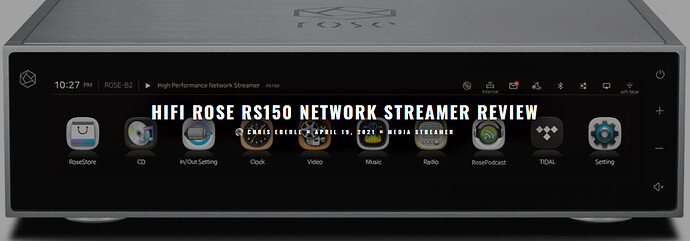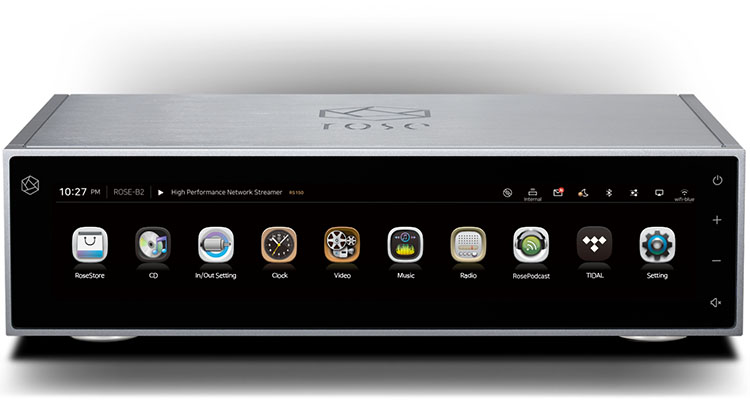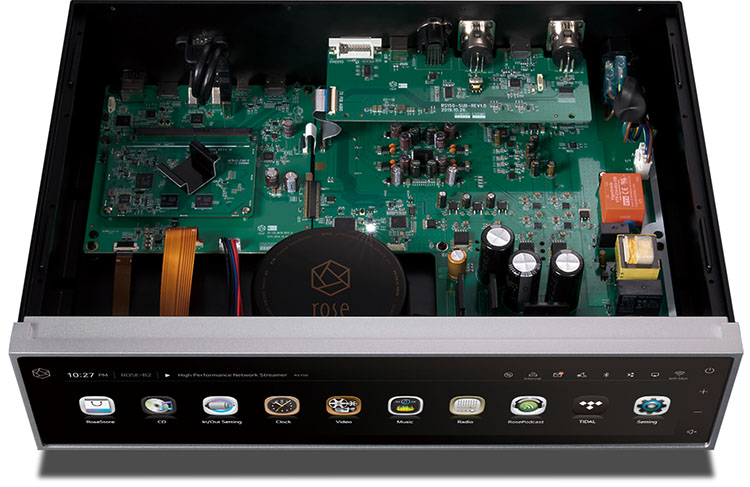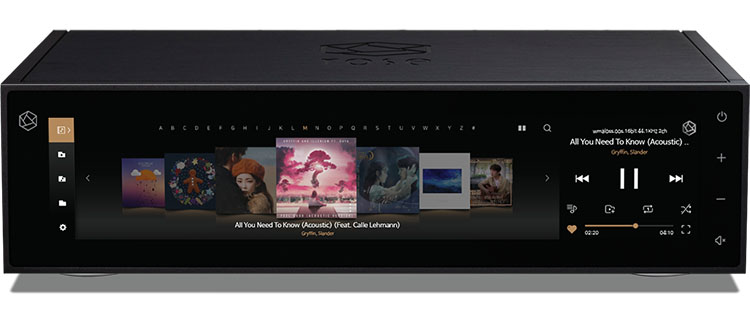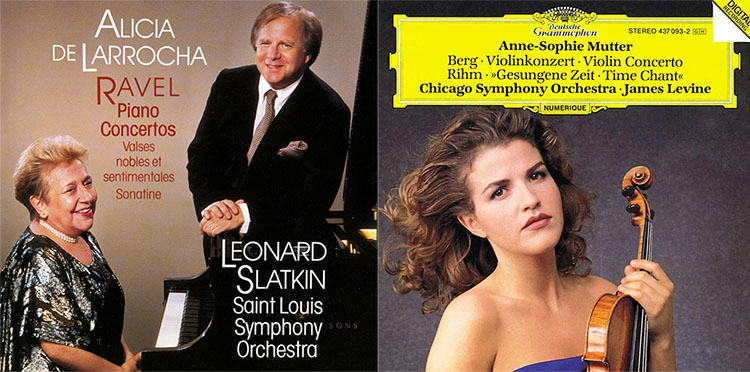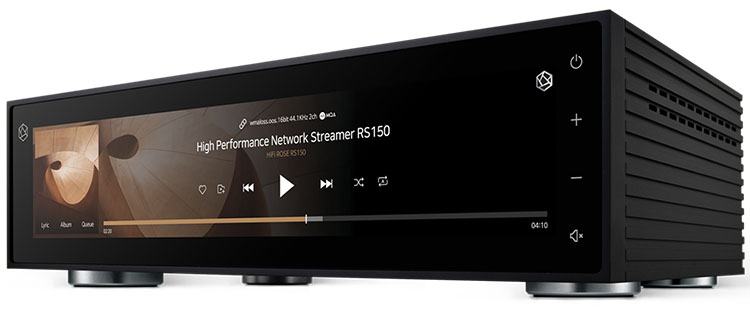URL : HiFi Rose RS150 Network Streamer Review - HomeTheaterHifi.com
The HiFi Rose RS150 Network Streamer is a truly versatile component. Not only can it stream audio from every imaginable network source, but it also has a fully capable preamp section, a premium DAC, and the ability to stream video.
The HiFi Rose RS150 Network Streamer is a truly versatile component. Not only can it stream audio from every imaginable network source, but it also has a fully capable preamp section, a premium DAC, and the ability to stream video. It’s a veritable Swiss Army Knife of electronics. With a large front-mounted touch screen, you can access your favorite streaming service, play music over your home network, watch video through its HDMI output, and more. A Bluetooth remote means you can control the RS150 easily and it’s premium internals let you hook directly up to a power amplifier with a fully balanced signal if you wish. There is little it cannot do, and it is built like a tank to boot.
Highlights
HiFi Rose RS150 Network Streamer
- Streaming preamplifier with balanced output
- AKM AK4499EQ DAC
- Video capable, HDMI 2.0 with ARC
- Accepts SSD storage up to 4Tb
- Every imaginable input and output, analog and digital including I2S
- Large touchscreen control
- Bluetooth remote
- Premium build quality
Introduction
It can be said that source components have truly evolved into something we never would have imagined 20 years ago. We middle-aged audiophiles grew up with records and tapes and during our college years migrated to CDs. But even when the internet first became a thing, I never thought that streaming music would so dominantly replace physical media.
We’ve seen a slew of products that incorporate streaming into traditional preamp and amplifier designs. Today, I’ll be looking at one from a relatively new company based in Korea, HiFi Rose. Only recently introduced to the US market, HiFi Rose is a division of Citech, makers of home electronics for a wide variety of applications. HiFi Rose is dedicated to premium streaming source components and they have kindly shipped me their flagship streamer, the RS150, for review.
Though they call it a streamer, it is much more than that. It incorporates a high-end DAC in the form of AKM’s AK4499EQ. This is a chip found only in flagship components, like Anthem’s new AVM 90 surround processor. It also has a preamp section capable of up to 9 volts RMS output with volume control. This means the RS150 can be connected directly to your favorite power amp through balanced or single-ended connections. You can also use it as a music server by adding a solid-state drive up to 4Tb. Or connect it to your local NAS. There is quite a lot to see here so without further ado, let’s take a look.
HIFI ROSE RS150 NETWORK STREAMER SPECIFICATIONS
DESIGN:
2-channel preamplifier with streaming and DAC sections
OUTPUT LEVEL:
4.5Vrms unbalanced, 9Vrms balanced
SIGNAL-TO-NOISE RATIO @ 1KHZ:
117dB unbalanced, 120dB balanced
THD @ 1KHZ:
0.0003% unbalanced, 0.0002% balanced
THD+N @ 1KHZ:
0.0005% unbalanced, 0.0003% balanced
DAC:
Asahi Kasei VERITA AK4499EQ
MAXIMUM SAMPLING RATE:
PCM 32-bit/768kHz
DSD SUPPORT:
2.8-22.5792MHz (DSD64-512)
NETWORK:
Ethernet, WiFi with dongle
STREAMING:
AirPlay, DLNA, Roon, MQA
INTERNAL STORAGE:
up to 4Tb with user-supplied SSD
AUDIO INPUTS:
1x optical, 1x coax, 1x RCA, 1x AES/EBU, 1x HDMI, 1x USB
AUDIO OUTPUTS:
1x optical, 1x coax, 1x RCA, 1x XLR, 1x I2S-DVI, 1x I2S-RJ45, 1x AES/EBU
VIDEO OUTPUT:
1x HDMI 2.0 w/ARC (3840×2160 @ 60Hz)
STORAGE:
2x USB 3.0, MicroSD, SSD bay (4Tb max)
AUDIO CODECS:
WAV, FLAC, AIFF, WMA, MP3, OGG, APE, DFF, DSF, AAC, CDA, AMR, APE, EC3, E-EC3, MID, MPL, MP2, MPC, MPGA, M4A
DIMENSIONS WXHXD:
16.9” x 4.8” x 12.4”
WEIGHT:
28.6lbs
PRICE:
$3999
WEBSITE:
COMPANY DIRECTORY:
SECRETS TAGS:
hifi rose rs150 network streamer, hifi rose, streamer, preamp, wifi, airplay, review 2021
Linkbacks
Design
The RS150 is HiFi Rose’s flagship product. They’ve put only premium design and parts into its construction and that is evident the moment you lift it out of the box. It’s one of the heaviest source components I’ve ever encountered at nearly 30 pounds. The two main reasons for this are its toroidal power supply and the milled aluminum case. It’s truly built like a tank.
The DAC section is anchored by an AKM AK4499EQ. This chip is THE solution in many of the latest high-end components. Anthem is even using one in its upcoming flagship surround processor, the AVM 90. The chip supports 32-bit sampling up to 768kHz and up to DSD512. Jitter is kept at bay by a Femto timing chip, one of the most precise clocks available. The analog section features both balanced and single-ended outputs and is capable of up to nine volts output with volume control which means you can hook the RS150 directly up to a power amplifier.
The milled aluminum case comes in black or silver and regardless of color, features a touch screen that covers nearly all its front face. There are no mechanical controls on the RS150, but you do get a small remote that provides transport keys, menu navigation, and volume control. It works via Bluetooth, so you don’t have to point or worry about things like cabinet doors. But you won’t want to hide the RS150 away, it’s a beautifully styled box that just drips high end.
A touchscreen bordered by a metal frame covers the entire front of the RS150. It’s extremely versatile not only for control but for display. You can watch videos on it or view the album art of the currently playing selection. It can also show a clock or a pair of VU meters.
Codec and streaming support are extensive as one would expect from a $4000 component. In addition to every conceivable audio format, the RS150 supports video streaming as well, up to 2160p at 60Hz. You can stream video from the bundled RoseTube app or from your local network. Output from the RS150 is limited to two channels but you can pass multi-channel streams through the HDMI interface to an appropriate processor or receiver.
The remote struck me as the only thing that didn’t quite belong with a $4000 audio component. The handset, while very functional, feels a bit cheap and is not backlit. But there is an alternative way to control the RS150, with the HiFi Rose app. This makes sense given the number of streaming services that are managed from phones and tablets. Switching to the Rose app to adjust the volume or change a setting is more conveniently done that way than hunting for yet another remote. So, I can forgive the quality of the included handset.
The RS150 includes every imaginable input and output for both analog and digital operation. In addition to the traditional RCA, coax, and optical connections, there are XLRs for balanced signals, two USBs, and one each of AES/EBU (in & out) and I2S. This last one comes in both a special XLR-style or DVI jack with a pin-out diagram printed on the panel. The USB-A input is asynchronous which means it reclocks the incoming data stream to eliminate jitter from misaligned timing. A third USB port is dedicated to the WiFi dongle which was included with my sample. The input panel is rounded out by HDMI 2.0 in and out ports which support Audio Return Channel (ARC). The only thing missing are balanced inputs which one might want to use with a CD player.
To add local storage, there is a MicroSD card slot in the back and a 2.5” SSD bay on the bottom. You’ll have to supply your own drive. The RS150 accepts up to 4Tb which at present will cost you around $450. Mounting screws are included in the box.
Setup
The RS150 comes carefully packed in flexible foam, not the crumbly kind, which I greatly appreciated. I was amazed by its weight, though, once I realized that it wasn’t just a streamer but a fully capable preamp, it made more sense. I connected the balanced outputs directly to an Emotiva XPA-5 power amp driving a pair of Axiom LFR1100 towers. The WiFi dongle was plugged in and I quickly connected to my home’s network.
Though the remote appears to have an IR transmitter, it works only via Bluetooth and must be paired during installation. Once complete, I did the requisite firmware update and I was ready to rock. The RS150 was immediately recognized by my iPhone as an AirPlay device and within five minutes, I was listening to a Vivaldi bassoon concerto.
To check out the RS150’s video functions, I connected an Anthem LTX-500 projector to the HDMI output. An app on the front panel opens up a configuration screen where you can easily route the signal path in and out of the huge array of connections.
In Use
The RS150 includes apps for Tidal and Qobuz. More apps are planned for future updates like Spotify and Deezer. There’s a radio app that offers hundreds of feeds from several different countries. AirPlay is the easiest way to get up and running because any iOS device will see the Rose and stream to it. I did most of my listening that way since my iTunes library is all lossless CD rips.
Speaking of CD rips, the RS150 can rip CDs directly to its internal SSD if you have one installed or to your local NAS through its DLNA interface. That makes it a fully capable music server. The RS150 is also Roon capable and will connect to the Roon core without user intervention. If you just want to play a CD, you can connect a player to one of the digital inputs, coax or optical, or HDMI. Or you can hook up an external CD drive to one of the USB ports for playback. I tried this with a $20 Dell USB CDROM drive and was rewarded with superb audio quality. While playing, the remote’s transport keys controlled the track selection and play/pause.
Listening to a few classical selections, I was immediately struck by the RS150’s tremendous dynamic range and warmth. Looking at my reference system, I realized that I’d been listening to the Burr-Brown DAC in my Integra DHC-80.1 processor for over 10 years. Though I’ve heard other more capable DACs in the interim, it was only for a few weeks at a time. The AKM AK4499EQ makes a clearly audible difference. Not only is it far richer and more detailed, it’s unfailingly honest. It takes neutrality to a new level. The RS150 will not do poor recordings any favors. You will hear every flaw and every wonder from the original.
Mahler Shostakovich, Fifth Symphony; San Francisco Symphony and the Kirov Orchestra, Ninth Symphony
Most of my reference material is of excellent quality. I started with my go-to Mahler’s Fifth Symphony with the San Francisco Symphony and the Kirov Orchestra’s performance of Shostakovich’s Ninth Symphony. These are SACDs ripped to my library as two-channel tracks, uncompressed. The RS150 really opened up the soundstage on these, almost to the point where I could believe I was listening to the multi-channel version. Using only my LFR1100 towers with no subwoofer or room correction, there was fantastic bass control and balance. The wet sound of the Shostakovich recording shone through while the Mahler symphony was a bit drier, just like the originals. The only downside to the RS150’s honest presentation is that I had to adjust the volume more often. Dynamic range is tremendous.
To sample something completely different, I selected the West Point Band CD, Tribute to Percy Grainger. This recording, in which I played as principal bassoon, was made in West Point’s Eisenhower Hall which is musician-speak is known as “a barn.” It’s a huge hall, wholly unsuited to classical music and as such, produces a very dry and distant sound. The best compensation is to close-mic the musicians and you can clearly hear that technique in use here. You can also hear every breath, every instrument key click, and every seat creak. But the overall balance is very nice, and the sound stage has depth as well as width.
Berg, Violin Concerto; Ravel, Piano Concerto
To compare streaming versus CD quality, I tried my recordings of Berg’s Violin Concerto and Ravel’s Piano Concerto. I could not hear a difference between the lossless version streamed via Airplay and playing the CD through a USB-connected transport. And that is as it should be. The RS150 rendered both albums with superb detail, a huge soundstage, and a generous warm sound. The AKM DAC is a real revelation for someone accustomed to the more mundane Burr-Browns from a decade ago.
Beatles Sgt. Pepper’s Lonely Hearts Club Band; Foo Fighters, One By One
Of course, I had to be sure the RS150 could rock too so I started with the remastered Beatles album, Sgt. Pepper’s Lonely Hearts Club Band. My version predates the 50th-anniversary edition that remixes the stereo original. While it has been described as lifeless by some picky audiophiles, the RS150 made it anything but. Though it wasn’t a live performance, it was recorded to sound that way and I was easily fooled. The sense of space is palpable and the band sounds as if they’re on a stage above my seat. The vintage feel is there too with polite but tactile bass, warm highs, and a neutral midrange. I could listen to the Beatles all day on the RS150.
Foo Fighters’ One By One came across as thoroughly modern though not quite up to the quality of later CDs mixed with Dave Grohl’s Neve console. But the bass really came alive with no subwoofer required. I missed the room correction here and there as my room’s modes were briefly excited, but the overall balance was superb. I thoroughly enjoyed listening to this entire album.
To watch video, I connected an Anthem LTX-500 projector to the RS150’s HDMI output and set the output resolution in the menu to 1080p/60. An application called “RoseTube” calls up a library of performances, in all genres, from YouTube. I suspect these are curated by HiFi Rose because many of them feature Korean pop stars. Video quality was variable as one would expect from YouTube but the 1080p streams looked very good. A few of them were mastered at 24p which caused a bit of judder because the RS150’s output frame rate is fixed. But 30p and 60p material was smooth and artifact-free. The sound quality was also variable but in a narrow range between very good and excellent.
Conclusions
The HiFi Rose RS150 Network Streamer isn’t cheap but it’s supremely versatile and boasts premium sound quality. There really isn’t another product like it.
LIKES
- Superb sound quality
- Slick touchscreen
- Incredibly versatile
- Premium build quality and styling
WOULD LIKE TO SEE
- A remote more befitting a $4000 component
- RS-232 and IR support
- More comprehensive user manual
The HiFi Rose RS150 Network Streamer isn’t the first streaming source component I’ve reviewed but it is definitely the most capable and versatile. With a huge array of inputs and outputs, both analog and digital, you can connect it to pretty much everything AV except a turntable. It’s premium AKM DAC and balanced output deliver superb sound that will completely change your perspective on digital to analog conversion if you’re used to more run-of-the-mill gear based on Burr-Brown chips.
With the top-notch build quality and beautiful styling, the RS150 looks at home in an equipment rack or on top of a nice piece of furniture. Its super-cool touchscreen means you won’t want to hide it away. The screen is not only functional, it creates a cool addition to the listening experience with its album art display and video capability. While I wished for a nicer remote, the included handset worked just fine over Bluetooth and provided the necessary functions for easy interaction.
The HiFi Rose RS150 Network Streamer is a truly unique product that wraps the abilities of multiple components into a single box. At $4000, it’s definitely in the premium category but I can’t think of another piece of equipment that does this much. I enjoyed experimenting with and listening to it, and I give it my highest recommendation

